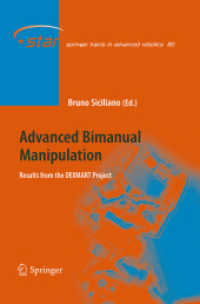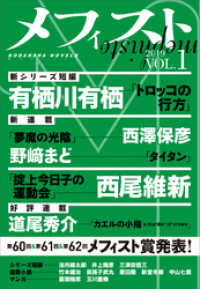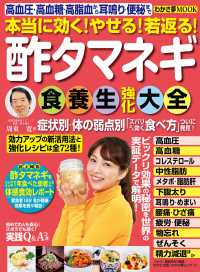- ホーム
- > 洋書
- > 英文書
- > Science / Mathematics
Full Description
An invaluable reference for an overall but simple approach to the complexity of quantum mechanics viewed through quantum oscillators
Quantum oscillators play a fundamental role in many areas of physics; for instance, in chemical physics with molecular normal modes, in solid state physics with phonons, and in quantum theory of light with photons. Quantum Oscillators is a timely and visionary book which presents these intricate topics, broadly covering the properties of quantum oscillators which are usually dispersed in the literature at varying levels of detail and often combined with other physical topics. These properties are: time-independent behavior, reversible dynamics, thermal statistical equilibrium and irreversible evolution toward equilibrium, together with anharmonicity and anharmonic couplings.
As an application of these intricate topics, special attention is devoted to infrared lineshapes of single and complex (undergoing Fermi resonance or Davydov coupling) damped H-bonded systems, providing key insights into this rapidly evolving area of chemical science.
Quantum Oscillators is a long overdue update in the literature surrounding quantum oscillators, and serves as an excellent supplementary text in courses on IR spectroscopy and hydrogen bonding. It is a must-have addition to the library of any graduate or undergraduate student in chemical physics.
Contents
List of Figures. Preface.
Acknowledgments.
PART 1: BASIS REQUIRED FOR QUANTUM OSCILLATOR STUDIES.
CHAPTER 1: BASIC CONCEPTS REQUIRED FOR QUANTUM MECHANICS.
1.1 Basic Concepts of Complex Vectorial Spaces.
1.2 Hermitian Conjugation.
1.3 Hermiticity and Unitarity.
1.4 Algebra Operators.
CHAPTER 2: BASIS FOR QUANTUM APPROACHES OF OSCILLATORS.
2.1 Oscillator Quantization at the Historical Origin of Quantum Mechanics.
2.2 Quantum Mechanics Postulates and Noncommutativity.
2.3 Heisenberg Uncertainty Relations.
2.4 Schrödinger Picture Dynamics.
2.5 Position or Momentum Translation Operators.
2.6 Conclusion.
CHAPTER 3: QUANTUM MECHANICS REPRESENTATIONS.
3.1 Matrix Representation.
3.2 Wave Mechanics.
3.3 Evolution Operators.
3.4 Density operators.
3.5 Conclusion.
CHAPTER 4: SIMPLE MODELS USEFUL FOR QUANTUM OSCILLATOR PHYSICS.
4.1 Particle-in-a-Box Model.
4.2 Two-Energy-Level Systems.
4.3 Conclusion.
PART II: SINGLE QUANTUM HARMONIC OSCILLATORS.
CHAPTER 5: ENERGY REPRESENTATION FOR QUANTUM HARMONIC OSCILLATOR.
5.1 Hamiltonian Eigenkets and Eigenvalues.
5.2 Wavefunctions Corresponding to Hamiltonian Eigenkets.
5.3 Dynamics.
5.4 Boson and fermion operators.
5.5 Conclusion.
CHAPTER 6: COHERENT STATES AND TRANSLATION OPERATORS.
6.1 Coherent-State Properties.
6.2 Poisson Density Operator.
6.3 Average and Fluctuation of Energy.
6.4 Coherent States as Minimizing Heisenberg Uncertainty Relations.
6.5 Dynamics.
6.6 Translation Operators.
6.7 Coherent-StateWavefunctions.
6.8 Franck-Condon Factors.
6.9 Driven Harmonic Oscillators.
6.10 Conclusion.
CHAPTER 7: BOSON OPERATOR THEOREMS.
7.1 Canonical Transformations.
7.2 Normal and Antinormal Ordering Formalism.
7.3 Time Evolution Operator of Driven Harmonic Oscillators.
7.4 Conclusion.
CHAPTER 8: PHASE OPERATORS AND SQUEEZED STATES.
8.1 Phase Operators.
8.2 Squeezed States.
8.3 Bogoliubov-Valatin transformation.
8.4 Conclusion.
PART III: ANHARMONICITY.
CHAPTER 9: ANHARMONIC OSCILLATORS.
9.1 Model for Diatomic Molecule Potentials.
9.2 Harmonic oscillator perturbed by a Q3 potential.
9.3 Morse Oscillator.
9.4 Quadratic Potentials Perturbed by Cosine Functions.
9.5 Double-well potential and tunneling effect.
9.6 Conclusion.
CHAPTER 10: OSCILLATORS INVOLVING ANHARMONIC COUPLINGS.
10.1 Fermi resonances.
10.2 Strong Anharmonic Coupling Theory.
10.3 Strong Anharmonic Coupling within the Adiabatic Approximation.
10.4 Fermi Resonances and Strong Anharmonic Coupling within Adiabatic Approximation.
10.5 Davydov and Strong Anharmonic Couplings.
10.6 Conclusion.
PART IV: OSCILLATOR POPULATIONS IN THERMAL EQUILIBRIUM.
CHAPTER 11: DYNAMICS OF A LARGE SET OF COUPLED OSCILLATORS.
11.1 Dynamical Equations in the Normal Ordering Formalism.
11.2 Solving the linear set of differential equations (11.27).
11.3 Obtainment of the Dynamics.
11.4 Application to a Linear Chain.
11.5 Conclusion.
CHAPTER 12: DENSITY OPERATORS FOR EQUILIBRIUM POPULATIONS OF OSCILLATORS.
12.1 Boltzmann's H-Theorem.
12.2 Evolution Toward Equilibrium of a Large Population ofWeakly Coupled Harmonic Oscillators.
12.3 Microcanonical Systems.
12.4 Equilibrium Density Operators from Entropy Maximization.
12.5 Conclusion.
CHAPTER 13: THERMAL PROPERTIES OF HARMONIC OSCILLATORS.
13.1 Boltzmann Distribution Law inside a Large Population of Equivalent Oscillators.
13.2 Thermal properties of harmonic oscillators.
13.3 Helmholtz Potential for Anharmonic Oscillators.
13.4 Thermal Average of Boson Operator Functions.
13.5 Conclusion.
PART V: QUANTUM NORMAL MODES OF VIBRATION.
CHAPTER 14: QUANTUM ELECTROMAGNETIC MODES.
14.1 Maxwell Equations.
14.2 Electromagnetic Field Hamiltonian.
14.3 Polarized Normal Modes.
14.4 Normal Modes of a Cavity.
14.5 Quantization of the Electromagnetic Fields.
14.6 Some Thermal Properties of the Quantum Fields.
14.7 Conclusion.
CHAPTER 15: QUANTUM MODES IN MOLECULES AND SOLIDS.
15.1 Molecular Normal Modes.
15.2 Phonons and Normal Modes in Solids.
15.3 Einstein and Debye Models of Heat Capacity.
15.4 Conclusion.
PART VI: DAMPED HARMONIC OSCILLATORS.
CHAPTER 16: DAMPED OSCILLATORS.
16.1 Quantum Model for Damped Harmonic Oscillators.
16.2 Second-Order Solution of Eq. (16.41).
16.3 Fokker-Planck Equation Corresponding to (16.114).
16.4 Nonperturbative Results for Density Operator.
16.5 Langevin Equations for Ladder Operators.
16.6 Evolution Operators of Driven Damped Oscillators.
16.7 Conclusion.
PART VII: VIBRATIONAL SPECTROSCOPY.
CHAPTER 17: APPLICATIONS TO OSCILLATOR SPECTROSCOPY.
17.1 IR Selection Rules for Molecular Oscillators.
17.2 IR Spectra within the Linear Response Theory.
17.3 IR Spectra ofWeak H-Bonded Species.
17.4 SD of DampedWeak H-Bonded Species.
17.5 Approximation for Quantum Damping.
17.6 Damped Fermi Resonances.
17.7 H-Bonded IR Line Shapes Involving Fermi Resonance.
17.8 Line Shapes of H-Bonded Cyclic Dimers.
CHAPTER 18: APPENDIX.
18.1 An Important Commutator.
18.2 An Important Basic Canonical Transformation.
18.3 Canonical Transformation on a Function of Operators.
18.4 Glauber-Weyl Theorem.
18.5 Commutators of Functions of the P and Q operators.
18.6 Distribution Functions and Fourier Transforms.
18.7 Lagrange Multipliers Method.
18.8 Triple Vector Product.
18.9 Point Groups.
18.10 Scientific Authors Appearing in the Book.
Index.








